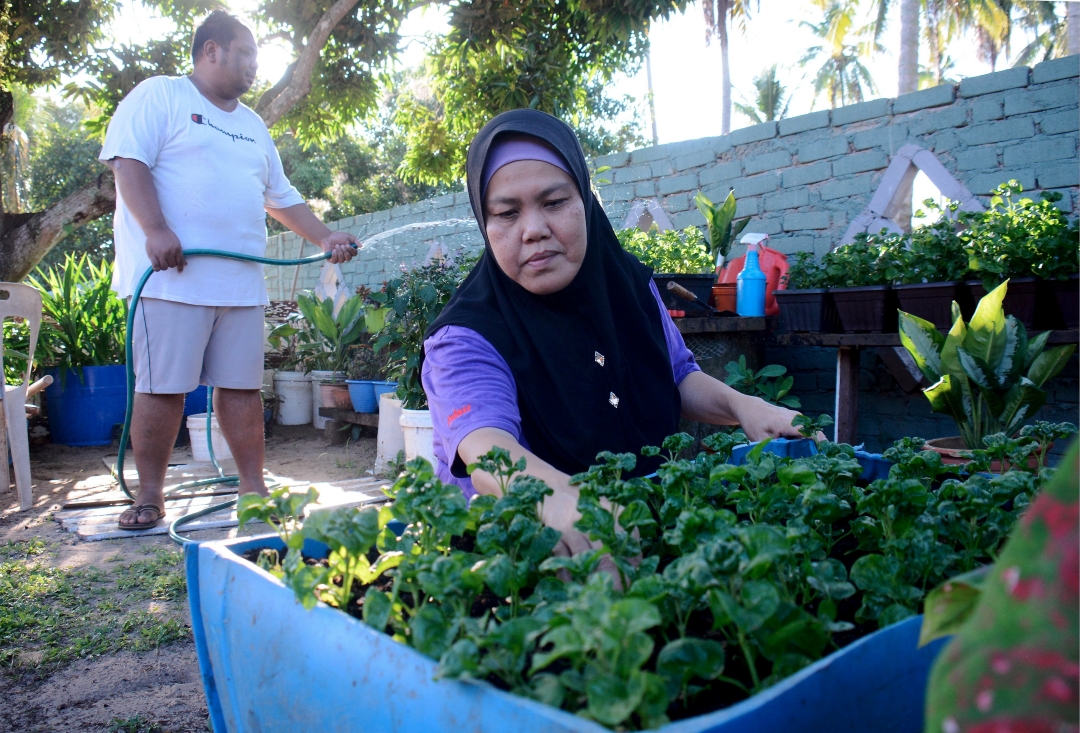
Nor Noriah Mat Jali, 57, and her son Mohd Zaimi Mohd Arip, 35, tend to their vegetables grown within the compound of their house in Kuantan. The duo has been planting many local varieties in their home garden since the first phase of the Movement Control Order took force in March 2020. — Bernama photo
DURING the last one and half years of the Covid-19 pandemic, everyone has been wondering about how to spend one’s time at home.
Some have tried growing hydroponic vegetables. News of such success by big-timers has spread far and wide, yet the basic soil-based cultivation remains highly viable.
Friends have gathered polymer boxes slated for soil-based cultivation.
Planting in pots has entered a new phase of interest amongst housewives, where the platforms for home vegetable planting now comprise the backyard, sidewalks or just any space that can receive good sunlight.
My friend sells potted soil and has said that top soil and burnt soil seem to be the new business trend – he has been asking me to supply them from my farm.
Another guy has said: “I am going to your farm for soil once my son has returned from outstation project, using his ‘Hilux’ to transport it (soil).”
My friend, Mr Lim, had earlier picked up some 20 bags for his new backyard veggie-growing project – this venture has proven to be a success, as published on iPhone for the ‘SAVA Urban Veggie Group’.
The auto-pot system is also on sale for the lazy lot, wanting to grow some specimens at home!
The ideal method/mechanism would still have to be keeping the veggies healthy by using the right nutrients, preventing any attack from pests including snails and insects, and also removing all the troublesome weeds coming up together in the bed.
To sum it up, really pay attention to the environment and the methods of housing the veggies.
As far as my farming project goes, it has been over three years of easy maintenance and my methods have been copied by others; thus, I can recommend them to my readers here now.
1. Design a planting box plan, with the size (length, width and depth) being suitable to your needs in terms of growing veggies. It should not be too wide that our hands cannot reach over to the middle of the box. Having chosen your open space that would get maximum sunlight most of the days, we can first lay down the base using the gardening grade plastic sheet to isolate the original weeds from growing up again. We need to extend the size of coverage around the planter’s box for footpath and edges up to two feet wide. Now, measure the size of the boxes to be built. We can partition the boxes using wooden planks or block cement to hold the medium.
2. Fill in the boxes with the chosen medium, as per the veggie’s requirement, together with the basal nutrient dressing. The choice for growing common veggies like ‘chai sin’ (local mustard greens), ‘bayam’ (spinach), or lady’s fingers rests on them being short-term varieties; the long-term ones such as ‘chanko manis’ (manichai) and sweet potatoes can be picked and regrown, but these would require deeper beds as the root system would run deep. The medium for short-term veggies can be as shallow as eight inches. All other tree crops like papaya must not be grown from a planter’s box as this would ruin the medium as the roots would extend very far below and tree itself, along with the leaved, could cast large shadow over the rest of the area.
3. Planting by seeds or cuttings as propagators might benefit more from using a seedling tray to sow the seeds and transplant the seedlings very efficiently. I have done this for pumpkins and brinjals, against the use of polybags for fruit crops.
4. Maintenance and control over heat and dryness – watering the veggies twice a day is good, if the weather is not ideal. Practise stringent pest prevention, and do hand-picking for pests, if possible, which is better than using pesticides.
Nutrients improvement takes many forms nowadays; we have foliar spray liquid formulation – just mix with water at a rate of 1:10 for a weak solution to avoid scalding the veggies. Pallet NPK takes 5:5:5; or urea premixed with water for drenching is also ideal for many veggies. Adding burnt earth or humus compost would help too. My friend has coconut husk fibres for mulching, which is even more ideal to preserve moisture and keep away weeds.
Some may even put up netting to prevent pests from destroying all their efforts. Here, you may encourage your children to look out the aphids or bugs as they (the children) are more observant.
5. Time to harvest is quite definite and precise for many veggies; otherwise, they may turn out to be too old and too fibrous if picked late. There are various ways for testing the veggies: as an example, a lady’s finger plant should be ready for harvest in about four days after the emergence of flowers. The right harvesting time of many kinds of leafy veggies can range from two to three weeks; in most cases, the timing is to ensure tenderness.
I really hope that there would be more home gardeners coming out in the open space to enjoy the sunlight and also a good sweat, as the majority of my former colleagues would agree.
Happy Gardening!
